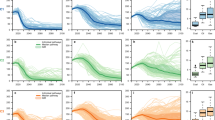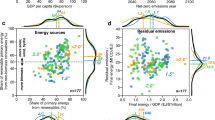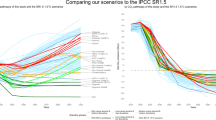Abstract
Energy technologies emit greenhouse gases with differing radiative efficiencies and atmospheric lifetimes1,2,3. Standard practice for evaluating technologies, which uses the global warming potential (GWP) to compare the integrated radiative forcing of emitted gases over a fixed time horizon4, does not acknowledge the importance of a changing background climate relative to climate change mitigation targets5,6. Here we demonstrate that the GWP misvalues the impact of CH4-emitting technologies as mid-century approaches, and we propose a new class of metrics to evaluate technologies based on their time of use. The instantaneous climate impact (ICI) compares gases in an expected radiative forcing stabilization year, and the cumulative climate impact (CCI) compares their time-integrated radiative forcing up to a stabilization year. Using these dynamic metrics, we quantify the climate impacts of technologies and show that high-CH4-emitting energy sources become less advantageous over time. The impact of natural gas for transportation, with CH4 leakage, exceeds that of gasoline within 1–2 decades for a commonly cited 3 W m−2 stabilization target. The impact of algae biodiesel overtakes that of corn ethanol within 2–3 decades, where algae co-products are used to produce biogas and corn co-products are used for animal feed. The proposed metrics capture the changing importance of CH4 emissions as a climate threshold is approached, thereby addressing a major shortcoming of the GWP for technology evaluation7,8.
This is a preview of subscription content, access via your institution
Access options
Subscribe to this journal
Receive 12 print issues and online access
$209.00 per year
only $17.42 per issue
Buy this article
- Purchase on Springer Link
- Instant access to full article PDF
Prices may be subject to local taxes which are calculated during checkout





Similar content being viewed by others
Change history
25 April 2014
In the print version of this Letter, the y axes in Fig. 4a,b should have been labelled 'Impact (g CO2-eq km-1)'. In addition, the first sentence of the author contributions should have read 'J.E.T. developed the concept and designed the methods for the study.' These errors have been corrected in the HTML and PDF versions of the Letter.
References
Alvarez, R. A., Pacala, S. W., Winebrake, J. J., Chameides, W. L. & Hamburg, S. P. Greater focus needed on methane leakage from natural gas infrastructure. Proc. Natl Acad. Sci. USA 109, 6435–6440 (2012).
Frank, E. D., Han, J., Palou-Rivera, I., Elgowainy, A. & Wang, M. Q. Methane and nitrous oxide emissions affect the life-cycle analysis of algal biofuels. Environ. Res. Lett. 7, 1–10 (2012).
Stratton, R. W., Wolfe, P. J. & Hileman, J. I. Impact of aviation non-CO2 combustion effects on the environmental feasibility of alternative jet fuels. Environ. Sci. Technol. 45, 10736–10743 (2011).
Solomon, S. et al. Climate Change 2007: The Physical Science Basis (Cambridge Univ. Press, (2007).
Daniel, J. S. et al. Limitations of single-basket trading: Lessons from the Montreal Protocol for climate policy. Climatic Change 111, 241–248 (2011).
Smith, S. M. et al. Equivalence of greenhouse-gas emissions for peak temperature limits. Nature Clim. Change 2, 8–11 (2012).
Azar, C. & Johansson, D. J. A. Valuing the non-CO2 climate impacts of aviation. Climatic Change 111, 559–579 (2011).
Peters, G. P., Aamaas, B., Lund, M. T., Solli, C. & Fuglestvedt, J. S. Alternative ‘global warming’ metrics in life cycle assessment: A case study with existing transportation data. Environ. Sci. Technol. 45, 8633–8641 (2011).
Kendall, A. Time-adjusted global warming potentials for LCA and carbon footprints. Int. J. Life Cycle Ass. 17, 1042–1049 (2012).
Shine, K. P. The global warming potential—the need for an interdisciplinary retrial. Climatic Change 96, 467–472 (2009).
Tanaka, K., Johansson, D. J. A., O’Neill, B. C. & Fuglestvedt, J. S. Emissions metrics under a 2 °C stabilization target. Climatic Change 117, 933–941 (2013).
Fuglestvedt, J. S. et al. Metrics of climate change: Assessing radiative forcing and emission indices. Climatic Change 58, 267–331 (2003).
Tol, R. S. J., Berntsen, T. K., O’Neill, B. C., Fuglestvedt, J. S. & Shine, K. P. A unifying framework for metrics for aggregating the climate effect of different emissions. Environ. Res. Lett. 7, 044006 (2012).
Fuglestvedt, J. S. et al. Transport impacts on atmosphere and climate: Metrics. Atmos. Environ. 44, 4648–4677 (2010).
Shine, K. P., Fuglestvedt, J. S., Hailemariam, K. & Stuber, N. Alternatives to the global warming potential for comparing climate impacts of emissions of greenhouse gases. Climatic Change 68, 281–302 (2005).
Shine, K. P., Berntsen, T. K., Fuglestvedt, J. S., Skeie, R. B. & Stuber, N. Comparing the climate effect of emissions of short- and long-lived climate agents. Phil. Trans. R. Soc. A 365, 1903–1914 (2007).
Manne, A. S. & Richels, R. G. An alternative approach to establishing trade-offs among greenhouse gases. Nature 410, 675–677 (2001).
Johansson, D. J. A. Economics- and physical-based metrics for comparing greenhouse gases. Climatic Change 110, 123–141 (2012).
Howarth, R. W., Santoro, R. & Ingraffea, A. Methane and the greenhouse-gas footprint of natural gas from shale formations. Climatic Change 106, 679–690 (2011).
Allen, D. T. et al. Measurements of methane emissions at natural gas production sites in the United States. Proc. Natl Acad. Sci. USA 110 (2013).
Weber, C. L. & Calvin, C. Life cycle carbon footprint of shale gas: Review of evidence and implications. Environ. Sci. Technol. 46, 5688–5695 (2012).
Burnham, A. et al. Life-cycle greenhouse gas emissions of shale gas, natural gas, coal, and petroleum. Environ. Sci. Technol. 46, 619–627 (2011).
United Nations Framework Convention on Climate Change. Report of the Conference of the Parties on its fifteenth session, held in Copenhagen from 7 to 19 December 2009, FCCC/CP/2009/11/Add.1
Ekholm, T., Lindroos, T. J. & Savolainen, I. Robustness of climate metrics under climate policy ambiguity. Environ. Sci. Policy 31, 44–52 (2013).
Liska, A. J. et al. Improvements in life cycle energy efficiency and greenhouse gas emissions of corn-ethanol. J. Ind. Ecol. 13, 58–74 (2009).
Scott, S. A. et al. Biodiesel from algae: Challenges and prospects. Curr. Opin. Biotechnol. 21, 277–286 (2010).
Alley, R. B. et al. Abrupt climate change. Science 299, 2005–2010 (2003).
Lenton, T. M. Beyond 2 °C: Redefining dangerous climate change for physical systems. WIREs Clim. Change 2, 451–461 (2011).
Lenton, T. M. et al. Tipping elements in the Earth’s climate system. Proc. Natl Acad. Sci. USA 105, 1786–1793 (2008).
Allen, M. R. et al. Warming caused by cumulative carbon emissions towards the trillionth tonne. Nature 458, 1163–1166 (2009).
Acknowledgements
The authors thank J. McNerney for his contributions to the development of the metric testing model. We thank S. Solomon for helpful feedback on this manuscript. This research was partially financially supported by the New England University Transportation Center at MIT under DOT grant No. DTRT07-G-0001.
Author information
Authors and Affiliations
Contributions
J.E.T. developed the concept and designed the methods for the study, M.R.E. and J.E.T. performed the analysis, J.E.T. and M.R.E. wrote the paper.
Corresponding author
Ethics declarations
Competing interests
The authors declare no competing financial interests.
Supplementary information
Rights and permissions
About this article
Cite this article
Edwards, M., Trancik, J. Climate impacts of energy technologies depend on emissions timing. Nature Clim Change 4, 347–352 (2014). https://doi.org/10.1038/nclimate2204
Received:
Accepted:
Published:
Issue Date:
DOI: https://doi.org/10.1038/nclimate2204
This article is cited by
-
Consequences of equivalency metric design for energy transitions and climate change
Climatic Change (2022)
-
Increase in frequency of nuclear power outages due to changing climate
Nature Energy (2021)
-
A price on warming with a supply chain directed market
Discover Sustainability (2021)
-
A theoretical basis for the equivalence between physical and economic climate metrics and implications for the choice of Global Warming Potential time horizon
Climatic Change (2020)
-
Climate policy for short- and long-lived pollutants
Nature Climate Change (2018)



